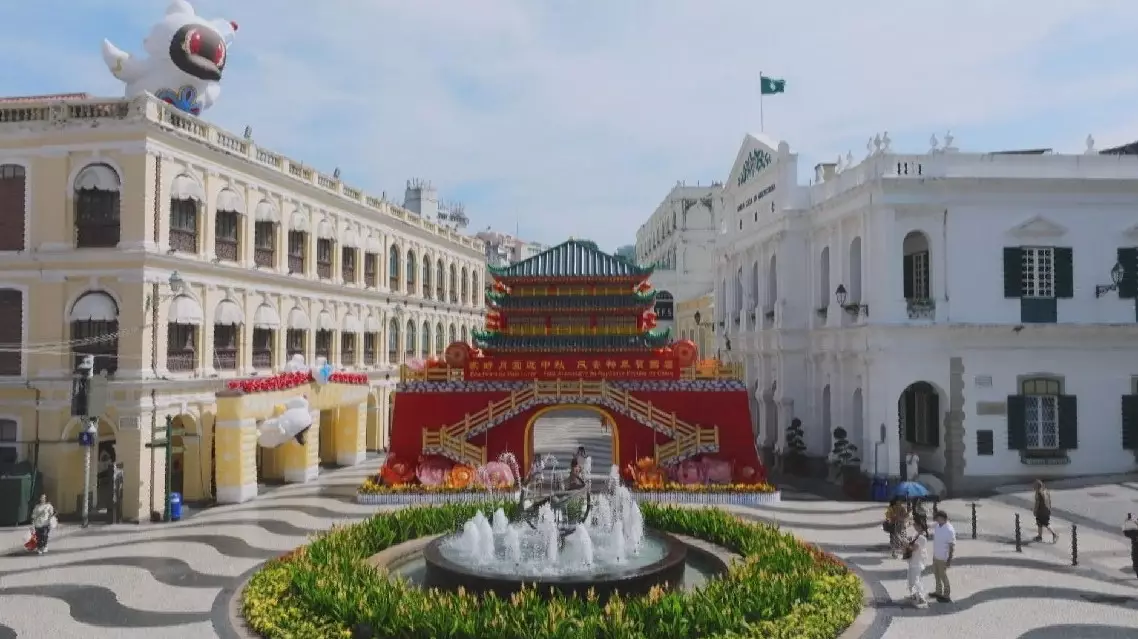As the 25th anniversary of Macao's return to China is approaching, the China Media Group (CMG)'s on Friday released a five-part documentary for commemoration, highlighting the Macao Special Administrative Region's remarkable journey toward prosperity under the "one country, two systems" framework.
Titled "25 Years of Lotus Bond", the series premiere on CCTV-1 at 20:00 from December 13 to 17, with subsequent broadcasts on CCTV-4 and CCTV-13.
Featuring five thematic episodes - Love for the Home and the Nation, A Path of Diversity, The Flavor of Happiness, A City of Integration, and Gateway to the Future - the documentary showcases the successful practices of "one country, two systems" in Macao under the strategic guidance of the central government.
Through compelling stories, the film delves into the emotional and cultural bonds between Macao and the mainland. One of the stories is Macao's long-standing tradition of building National Day archways.
Every October, under the glow of neon lights and festooned banners, Macao's streets transform into an open-air gallery of nostalgia and national pride. The star of the show is the region’s beloved National Day archway, an elaborate, temporary structure that is partly an art installation, partly a history lesson, and partly a declaration of love for the motherland.
This year, this grandiose archway holds extra significance. Macao is gearing up for a "Double Jubilee" - celebrating the 75th anniversary of the founding of the People's Republic of China (PRC) and the 25th anniversary of Macao's return. While fireworks light up the sky, the archway lights up the hearts of locals.
The tradition of building the National Day archway in Macao dates back to 1949, the year the PRC was founded. The first archway, erected near the Macao General Post Office, was a modest affair compared to today's dazzling creations. But its purpose was clear: to trumpet China's achievements and to remind Macao's residents of their roots. The designs have evolved over time, influenced by national policies, major events, and cultural trends.
From September to November, the Municipal Affairs Bureau gallery hosted a retrospective exhibition showcasing the evolution of the National Day archways from the late 1940s to the early 1970s. On display were rare photographs, design sketches, and interviews with craftsmen, offering visitors a deeper understanding of this unique tradition.
"The National Day archways are a way for the people of Macao to collectively participate in national affairs," said Lam Fat Iam, chief curator of the special exhibition on National Day archways.
"Every year, after the archway is lit up, everybody -- young and old, families and friends -- hang out to visit each archway on the streets. It's a tradition to stroll through the archway," said Lok Hei, president of the Macao Artist Society.
Over the years, one recurring design has been particularly prominent: the Tian'anmen Rostrum. Many archways incorporate this iconic image alongside slogans celebrating the nation's achievements. These structures serve as both an artistic expression of Macao's identity and a reflection of its alignment with China's progress.
"I remember my predecessors telling me how they organized young people and workers to go to the mainland and support the nation's development after receiving the call from the country," said Lee Chong Cheng, director of the Macao Federation of Trade Unions.
Curator Chan Suk Yi emphasized the resilience and dedication of those earlier generations.
"What impresses me the most and remains unforgettable is how, despite the economic and material constraints of the time, our predecessors were so persistent and never wavered in their dedication and efforts. Their commitment and devotion is what today's youth should learn from," she said.
On December 20, 1999, the Chinese government resumed its exercise of sovereignty over Macao and established the Macao SAR.

National Day archways embody Macao's memories, national sentiment









